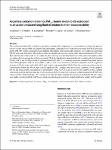Item Infomation
Full metadata record
| DC Field | Value | Language |
|---|---|---|
| dc.contributor.author | Expósito, A. | - |
| dc.contributor.author | Markiv, B. | - |
| dc.contributor.author | Santibáñez, M. | - |
| dc.date.accessioned | 2023-10-02T08:12:28Z | - |
| dc.date.available | 2023-10-02T08:12:28Z | - |
| dc.date.issued | 2023 | - |
| dc.identifier.uri | https://link.springer.com/article/10.1007/s11869-023-01436-8 | - |
| dc.identifier.uri | https://dlib.phenikaa-uni.edu.vn/handle/PNK/9398 | - |
| dc.description | CC-BY | vi |
| dc.description.abstract | The oxidative potential (OP) is defined as the ability of inhaled PM components to catalytically/non-catalytically generate reactive oxygen species (ROS) and deplete lung antioxidants. Although several studies have measured the OP of particulate matter (PM OP) soluble components using different antioxidants under neutral pH conditions, few studies have measured PM OP with acidic lung fluids. This study provides new insights into the use of acidic rather than neutral fluids in OP assays. Thus, the first aim of this study was to clarify the effect of using an acidic lung fluid on ascorbic acid (AA) depletion. This was achieved by measuring the oxidative potential (OP-AA) of individual compounds known to catalyze the AA oxidation (CuSO4, CuCl2, and 1,4-NQ) in artificial lysosomal fluid (ALF, pH 4.5), a commonly used acidic simulated lung fluid, and in a neutral fluid (phosphate-buffered saline (PBS1x), pH 7.4). | vi |
| dc.language.iso | en | vi |
| dc.publisher | Springer | vi |
| dc.subject | Ascorbate oxidation | vi |
| dc.subject | their bioaccessibility | vi |
| dc.title | Ascorbate oxidation driven by PM2.5-bound metal(loid)s extracted in an acidic simulated lung fluid in relation to their bioaccessibility | vi |
| dc.type | Book | vi |
| Appears in Collections | ||
| OER - Khoa học môi trường | ||
Files in This Item:

